A Report on International Human Resource Management at HSBC Group
VerifiedAdded on 2023/06/05
|11
|3180
|151
Report
AI Summary
This report provides a comprehensive analysis of HSBC's international human resource management (IHRM) practices, focusing on organizational development through mergers and acquisitions, wholly-owned subsidiaries, and international developmental strategies in Indonesia and Bangladesh. It examines HSBC's reward packages and pay systems, highlighting country-based compensation practices in India and Dubai. The report emphasizes HSBC's commitment to employee development, competitive compensation, and effective HR practices that contribute to its global success, with a focus on adapting strategies to local market norms and valuing employee feedback. Desklib offers this and many other solved assignments for students.
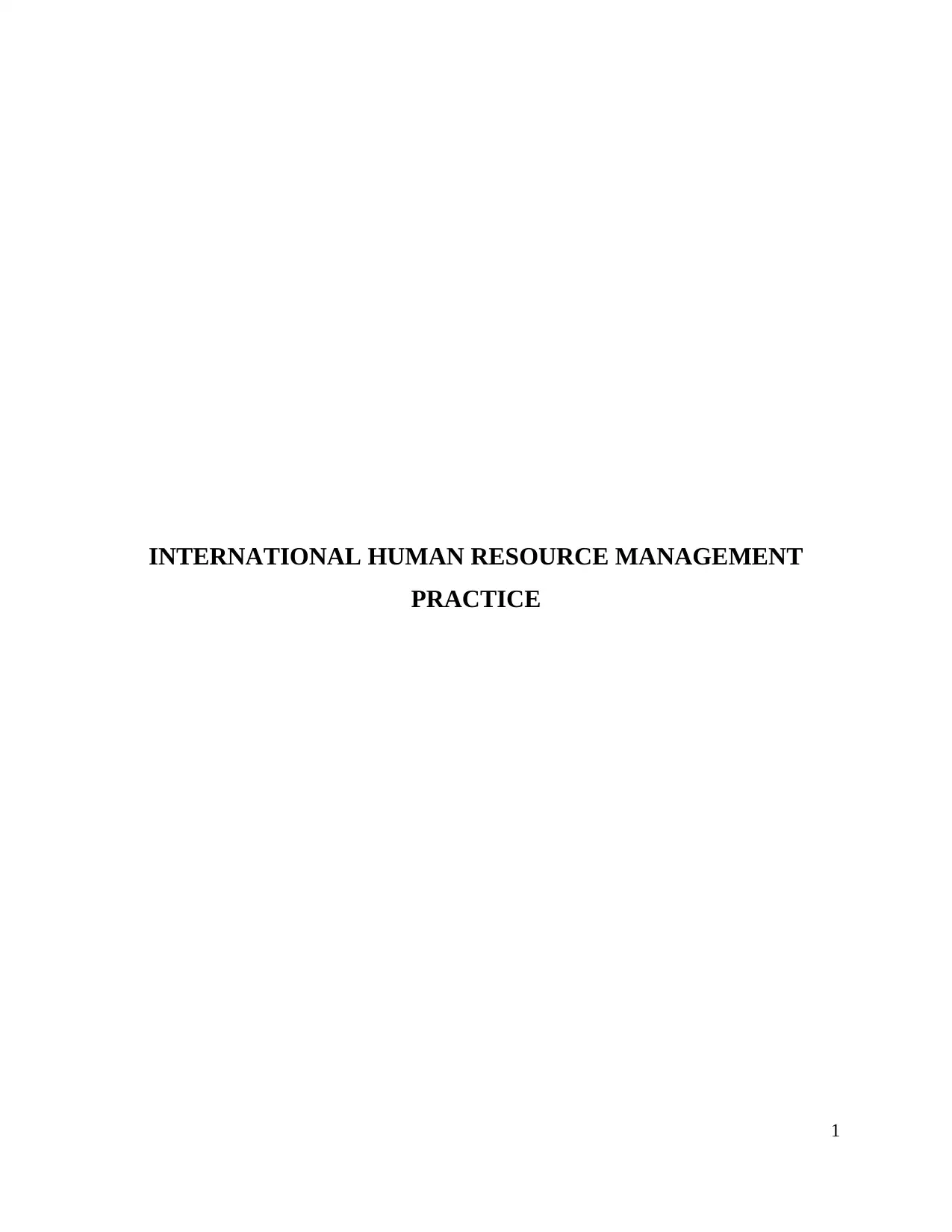
INTERNATIONAL HUMAN RESOURCE MANAGEMENT
PRACTICE
1
PRACTICE
1
Paraphrase This Document
Need a fresh take? Get an instant paraphrase of this document with our AI Paraphraser
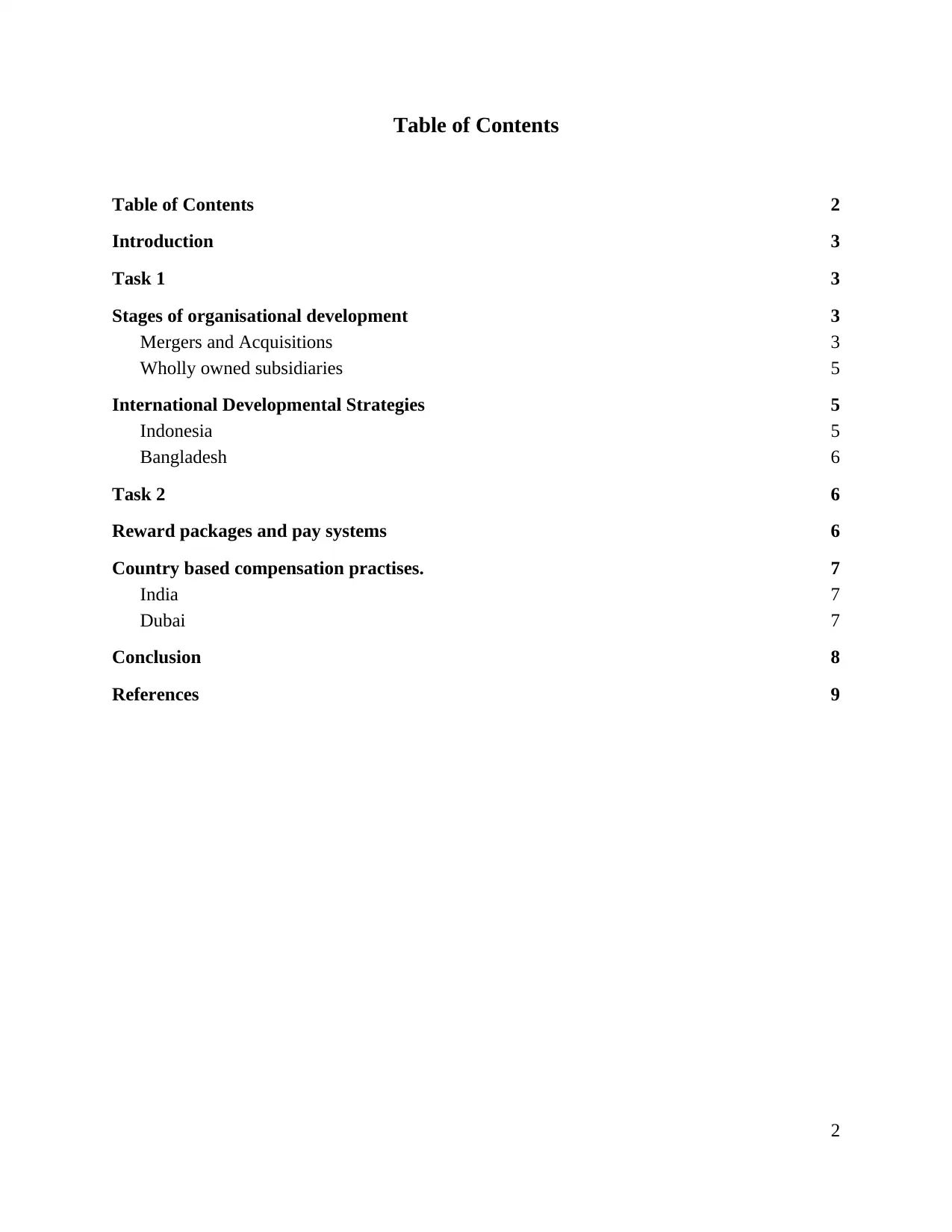
Table of Contents
Table of Contents 2
Introduction 3
Task 1 3
Stages of organisational development 3
Mergers and Acquisitions 3
Wholly owned subsidiaries 5
International Developmental Strategies 5
Indonesia 5
Bangladesh 6
Task 2 6
Reward packages and pay systems 6
Country based compensation practises. 7
India 7
Dubai 7
Conclusion 8
References 9
2
Table of Contents 2
Introduction 3
Task 1 3
Stages of organisational development 3
Mergers and Acquisitions 3
Wholly owned subsidiaries 5
International Developmental Strategies 5
Indonesia 5
Bangladesh 6
Task 2 6
Reward packages and pay systems 6
Country based compensation practises. 7
India 7
Dubai 7
Conclusion 8
References 9
2
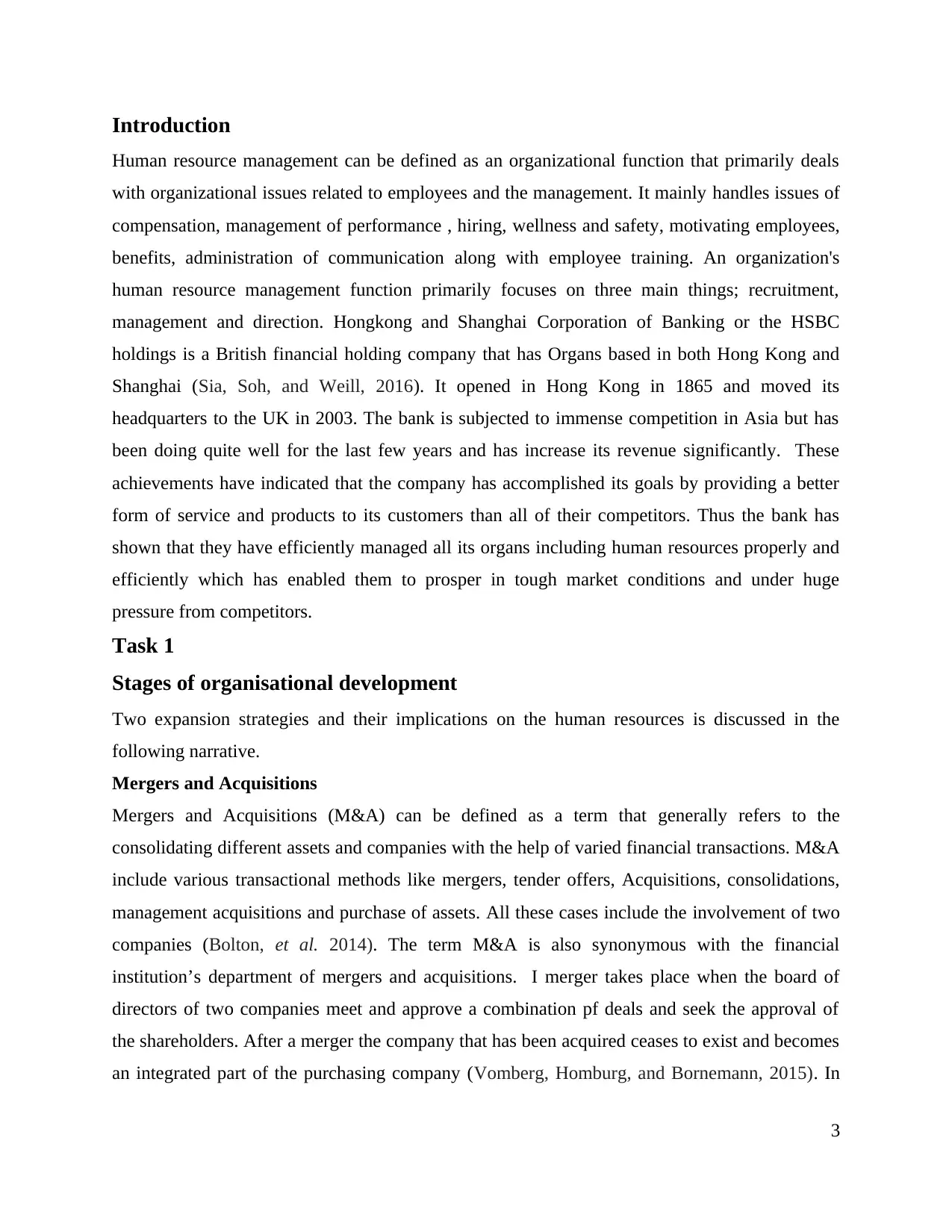
Introduction
Human resource management can be defined as an organizational function that primarily deals
with organizational issues related to employees and the management. It mainly handles issues of
compensation, management of performance , hiring, wellness and safety, motivating employees,
benefits, administration of communication along with employee training. An organization's
human resource management function primarily focuses on three main things; recruitment,
management and direction. Hongkong and Shanghai Corporation of Banking or the HSBC
holdings is a British financial holding company that has Organs based in both Hong Kong and
Shanghai (Sia, Soh, and Weill, 2016). It opened in Hong Kong in 1865 and moved its
headquarters to the UK in 2003. The bank is subjected to immense competition in Asia but has
been doing quite well for the last few years and has increase its revenue significantly. These
achievements have indicated that the company has accomplished its goals by providing a better
form of service and products to its customers than all of their competitors. Thus the bank has
shown that they have efficiently managed all its organs including human resources properly and
efficiently which has enabled them to prosper in tough market conditions and under huge
pressure from competitors.
Task 1
Stages of organisational development
Two expansion strategies and their implications on the human resources is discussed in the
following narrative.
Mergers and Acquisitions
Mergers and Acquisitions (M&A) can be defined as a term that generally refers to the
consolidating different assets and companies with the help of varied financial transactions. M&A
include various transactional methods like mergers, tender offers, Acquisitions, consolidations,
management acquisitions and purchase of assets. All these cases include the involvement of two
companies (Bolton, et al. 2014). The term M&A is also synonymous with the financial
institution’s department of mergers and acquisitions. I merger takes place when the board of
directors of two companies meet and approve a combination pf deals and seek the approval of
the shareholders. After a merger the company that has been acquired ceases to exist and becomes
an integrated part of the purchasing company (Vomberg, Homburg, and Bornemann, 2015). In
3
Human resource management can be defined as an organizational function that primarily deals
with organizational issues related to employees and the management. It mainly handles issues of
compensation, management of performance , hiring, wellness and safety, motivating employees,
benefits, administration of communication along with employee training. An organization's
human resource management function primarily focuses on three main things; recruitment,
management and direction. Hongkong and Shanghai Corporation of Banking or the HSBC
holdings is a British financial holding company that has Organs based in both Hong Kong and
Shanghai (Sia, Soh, and Weill, 2016). It opened in Hong Kong in 1865 and moved its
headquarters to the UK in 2003. The bank is subjected to immense competition in Asia but has
been doing quite well for the last few years and has increase its revenue significantly. These
achievements have indicated that the company has accomplished its goals by providing a better
form of service and products to its customers than all of their competitors. Thus the bank has
shown that they have efficiently managed all its organs including human resources properly and
efficiently which has enabled them to prosper in tough market conditions and under huge
pressure from competitors.
Task 1
Stages of organisational development
Two expansion strategies and their implications on the human resources is discussed in the
following narrative.
Mergers and Acquisitions
Mergers and Acquisitions (M&A) can be defined as a term that generally refers to the
consolidating different assets and companies with the help of varied financial transactions. M&A
include various transactional methods like mergers, tender offers, Acquisitions, consolidations,
management acquisitions and purchase of assets. All these cases include the involvement of two
companies (Bolton, et al. 2014). The term M&A is also synonymous with the financial
institution’s department of mergers and acquisitions. I merger takes place when the board of
directors of two companies meet and approve a combination pf deals and seek the approval of
the shareholders. After a merger the company that has been acquired ceases to exist and becomes
an integrated part of the purchasing company (Vomberg, Homburg, and Bornemann, 2015). In
3
⊘ This is a preview!⊘
Do you want full access?
Subscribe today to unlock all pages.

Trusted by 1+ million students worldwide
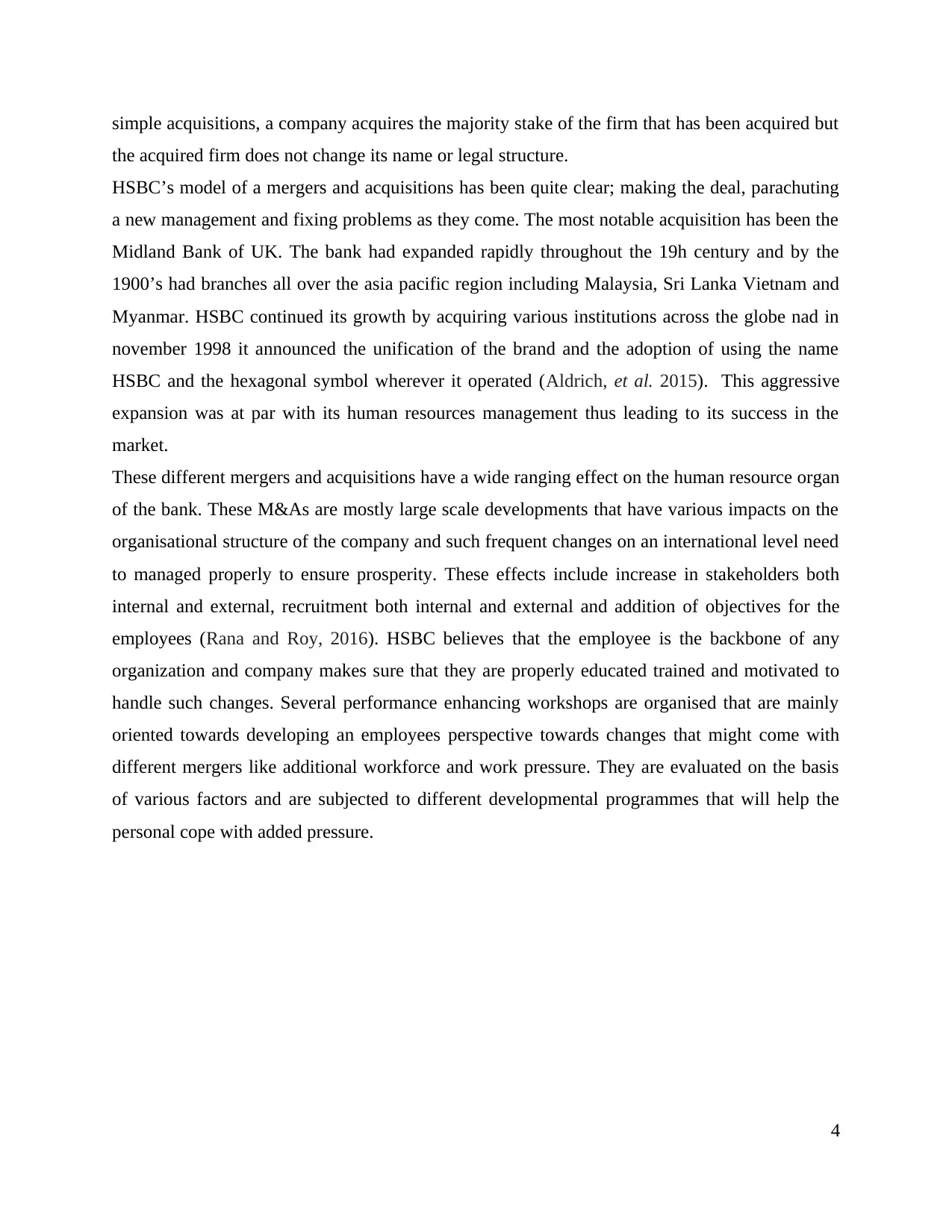
simple acquisitions, a company acquires the majority stake of the firm that has been acquired but
the acquired firm does not change its name or legal structure.
HSBC’s model of a mergers and acquisitions has been quite clear; making the deal, parachuting
a new management and fixing problems as they come. The most notable acquisition has been the
Midland Bank of UK. The bank had expanded rapidly throughout the 19h century and by the
1900’s had branches all over the asia pacific region including Malaysia, Sri Lanka Vietnam and
Myanmar. HSBC continued its growth by acquiring various institutions across the globe nad in
november 1998 it announced the unification of the brand and the adoption of using the name
HSBC and the hexagonal symbol wherever it operated (Aldrich, et al. 2015). This aggressive
expansion was at par with its human resources management thus leading to its success in the
market.
These different mergers and acquisitions have a wide ranging effect on the human resource organ
of the bank. These M&As are mostly large scale developments that have various impacts on the
organisational structure of the company and such frequent changes on an international level need
to managed properly to ensure prosperity. These effects include increase in stakeholders both
internal and external, recruitment both internal and external and addition of objectives for the
employees (Rana and Roy, 2016). HSBC believes that the employee is the backbone of any
organization and company makes sure that they are properly educated trained and motivated to
handle such changes. Several performance enhancing workshops are organised that are mainly
oriented towards developing an employees perspective towards changes that might come with
different mergers like additional workforce and work pressure. They are evaluated on the basis
of various factors and are subjected to different developmental programmes that will help the
personal cope with added pressure.
4
the acquired firm does not change its name or legal structure.
HSBC’s model of a mergers and acquisitions has been quite clear; making the deal, parachuting
a new management and fixing problems as they come. The most notable acquisition has been the
Midland Bank of UK. The bank had expanded rapidly throughout the 19h century and by the
1900’s had branches all over the asia pacific region including Malaysia, Sri Lanka Vietnam and
Myanmar. HSBC continued its growth by acquiring various institutions across the globe nad in
november 1998 it announced the unification of the brand and the adoption of using the name
HSBC and the hexagonal symbol wherever it operated (Aldrich, et al. 2015). This aggressive
expansion was at par with its human resources management thus leading to its success in the
market.
These different mergers and acquisitions have a wide ranging effect on the human resource organ
of the bank. These M&As are mostly large scale developments that have various impacts on the
organisational structure of the company and such frequent changes on an international level need
to managed properly to ensure prosperity. These effects include increase in stakeholders both
internal and external, recruitment both internal and external and addition of objectives for the
employees (Rana and Roy, 2016). HSBC believes that the employee is the backbone of any
organization and company makes sure that they are properly educated trained and motivated to
handle such changes. Several performance enhancing workshops are organised that are mainly
oriented towards developing an employees perspective towards changes that might come with
different mergers like additional workforce and work pressure. They are evaluated on the basis
of various factors and are subjected to different developmental programmes that will help the
personal cope with added pressure.
4
Paraphrase This Document
Need a fresh take? Get an instant paraphrase of this document with our AI Paraphraser
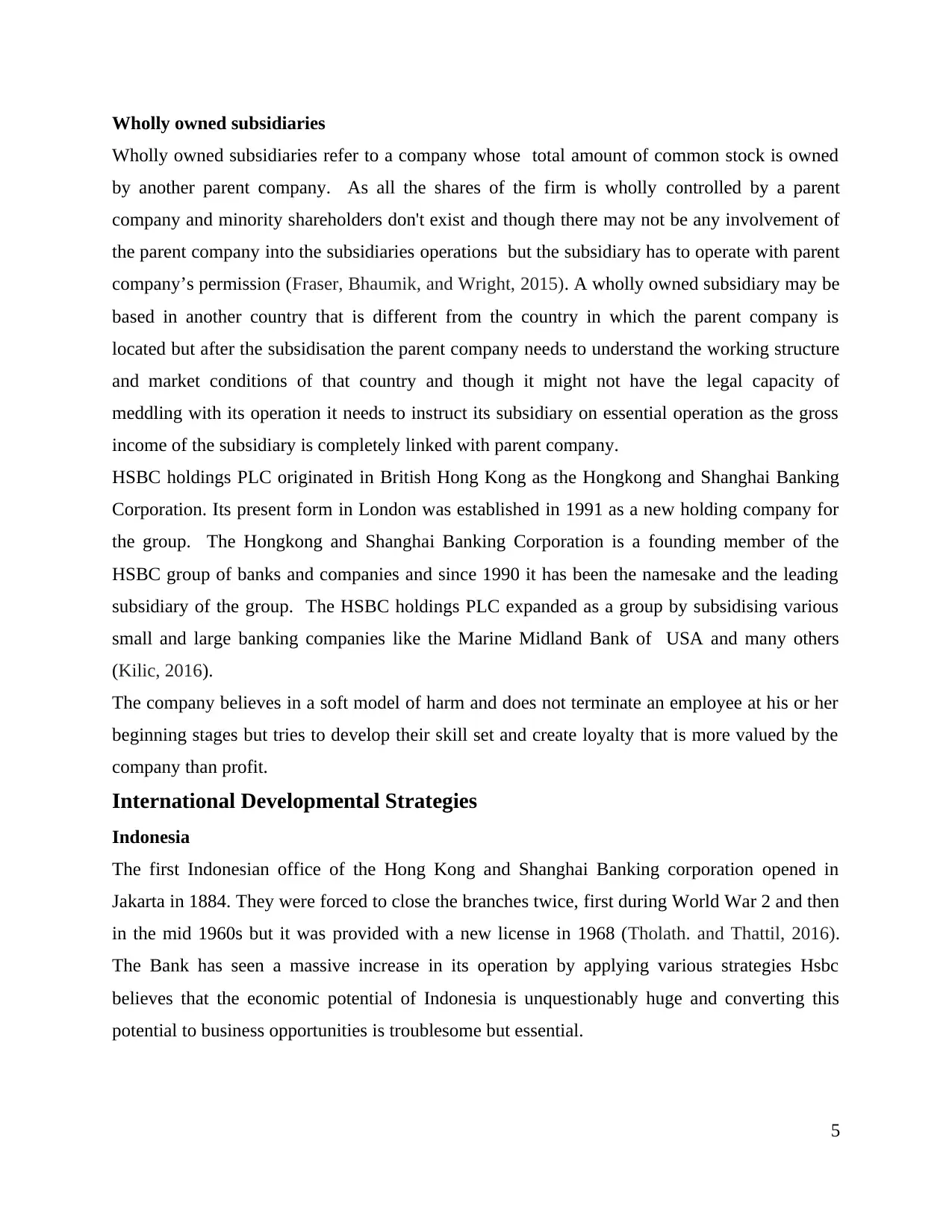
Wholly owned subsidiaries
Wholly owned subsidiaries refer to a company whose total amount of common stock is owned
by another parent company. As all the shares of the firm is wholly controlled by a parent
company and minority shareholders don't exist and though there may not be any involvement of
the parent company into the subsidiaries operations but the subsidiary has to operate with parent
company’s permission (Fraser, Bhaumik, and Wright, 2015). A wholly owned subsidiary may be
based in another country that is different from the country in which the parent company is
located but after the subsidisation the parent company needs to understand the working structure
and market conditions of that country and though it might not have the legal capacity of
meddling with its operation it needs to instruct its subsidiary on essential operation as the gross
income of the subsidiary is completely linked with parent company.
HSBC holdings PLC originated in British Hong Kong as the Hongkong and Shanghai Banking
Corporation. Its present form in London was established in 1991 as a new holding company for
the group. The Hongkong and Shanghai Banking Corporation is a founding member of the
HSBC group of banks and companies and since 1990 it has been the namesake and the leading
subsidiary of the group. The HSBC holdings PLC expanded as a group by subsidising various
small and large banking companies like the Marine Midland Bank of USA and many others
(Kilic, 2016).
The company believes in a soft model of harm and does not terminate an employee at his or her
beginning stages but tries to develop their skill set and create loyalty that is more valued by the
company than profit.
International Developmental Strategies
Indonesia
The first Indonesian office of the Hong Kong and Shanghai Banking corporation opened in
Jakarta in 1884. They were forced to close the branches twice, first during World War 2 and then
in the mid 1960s but it was provided with a new license in 1968 (Tholath. and Thattil, 2016).
The Bank has seen a massive increase in its operation by applying various strategies Hsbc
believes that the economic potential of Indonesia is unquestionably huge and converting this
potential to business opportunities is troublesome but essential.
5
Wholly owned subsidiaries refer to a company whose total amount of common stock is owned
by another parent company. As all the shares of the firm is wholly controlled by a parent
company and minority shareholders don't exist and though there may not be any involvement of
the parent company into the subsidiaries operations but the subsidiary has to operate with parent
company’s permission (Fraser, Bhaumik, and Wright, 2015). A wholly owned subsidiary may be
based in another country that is different from the country in which the parent company is
located but after the subsidisation the parent company needs to understand the working structure
and market conditions of that country and though it might not have the legal capacity of
meddling with its operation it needs to instruct its subsidiary on essential operation as the gross
income of the subsidiary is completely linked with parent company.
HSBC holdings PLC originated in British Hong Kong as the Hongkong and Shanghai Banking
Corporation. Its present form in London was established in 1991 as a new holding company for
the group. The Hongkong and Shanghai Banking Corporation is a founding member of the
HSBC group of banks and companies and since 1990 it has been the namesake and the leading
subsidiary of the group. The HSBC holdings PLC expanded as a group by subsidising various
small and large banking companies like the Marine Midland Bank of USA and many others
(Kilic, 2016).
The company believes in a soft model of harm and does not terminate an employee at his or her
beginning stages but tries to develop their skill set and create loyalty that is more valued by the
company than profit.
International Developmental Strategies
Indonesia
The first Indonesian office of the Hong Kong and Shanghai Banking corporation opened in
Jakarta in 1884. They were forced to close the branches twice, first during World War 2 and then
in the mid 1960s but it was provided with a new license in 1968 (Tholath. and Thattil, 2016).
The Bank has seen a massive increase in its operation by applying various strategies Hsbc
believes that the economic potential of Indonesia is unquestionably huge and converting this
potential to business opportunities is troublesome but essential.
5
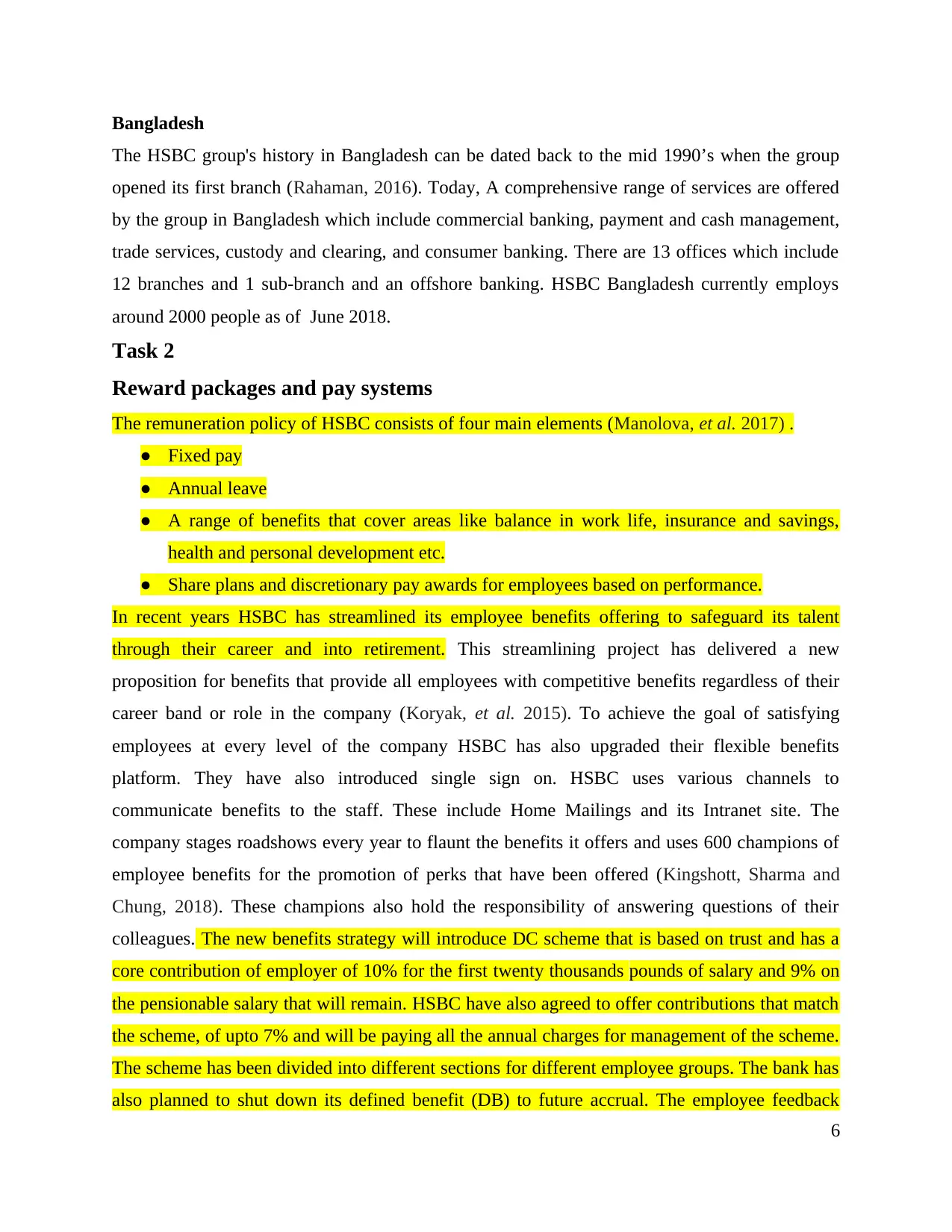
Bangladesh
The HSBC group's history in Bangladesh can be dated back to the mid 1990’s when the group
opened its first branch (Rahaman, 2016). Today, A comprehensive range of services are offered
by the group in Bangladesh which include commercial banking, payment and cash management,
trade services, custody and clearing, and consumer banking. There are 13 offices which include
12 branches and 1 sub-branch and an offshore banking. HSBC Bangladesh currently employs
around 2000 people as of June 2018.
Task 2
Reward packages and pay systems
The remuneration policy of HSBC consists of four main elements (Manolova, et al. 2017) .
● Fixed pay
● Annual leave
● A range of benefits that cover areas like balance in work life, insurance and savings,
health and personal development etc.
● Share plans and discretionary pay awards for employees based on performance.
In recent years HSBC has streamlined its employee benefits offering to safeguard its talent
through their career and into retirement. This streamlining project has delivered a new
proposition for benefits that provide all employees with competitive benefits regardless of their
career band or role in the company (Koryak, et al. 2015). To achieve the goal of satisfying
employees at every level of the company HSBC has also upgraded their flexible benefits
platform. They have also introduced single sign on. HSBC uses various channels to
communicate benefits to the staff. These include Home Mailings and its Intranet site. The
company stages roadshows every year to flaunt the benefits it offers and uses 600 champions of
employee benefits for the promotion of perks that have been offered (Kingshott, Sharma and
Chung, 2018). These champions also hold the responsibility of answering questions of their
colleagues. The new benefits strategy will introduce DC scheme that is based on trust and has a
core contribution of employer of 10% for the first twenty thousands pounds of salary and 9% on
the pensionable salary that will remain. HSBC have also agreed to offer contributions that match
the scheme, of upto 7% and will be paying all the annual charges for management of the scheme.
The scheme has been divided into different sections for different employee groups. The bank has
also planned to shut down its defined benefit (DB) to future accrual. The employee feedback
6
The HSBC group's history in Bangladesh can be dated back to the mid 1990’s when the group
opened its first branch (Rahaman, 2016). Today, A comprehensive range of services are offered
by the group in Bangladesh which include commercial banking, payment and cash management,
trade services, custody and clearing, and consumer banking. There are 13 offices which include
12 branches and 1 sub-branch and an offshore banking. HSBC Bangladesh currently employs
around 2000 people as of June 2018.
Task 2
Reward packages and pay systems
The remuneration policy of HSBC consists of four main elements (Manolova, et al. 2017) .
● Fixed pay
● Annual leave
● A range of benefits that cover areas like balance in work life, insurance and savings,
health and personal development etc.
● Share plans and discretionary pay awards for employees based on performance.
In recent years HSBC has streamlined its employee benefits offering to safeguard its talent
through their career and into retirement. This streamlining project has delivered a new
proposition for benefits that provide all employees with competitive benefits regardless of their
career band or role in the company (Koryak, et al. 2015). To achieve the goal of satisfying
employees at every level of the company HSBC has also upgraded their flexible benefits
platform. They have also introduced single sign on. HSBC uses various channels to
communicate benefits to the staff. These include Home Mailings and its Intranet site. The
company stages roadshows every year to flaunt the benefits it offers and uses 600 champions of
employee benefits for the promotion of perks that have been offered (Kingshott, Sharma and
Chung, 2018). These champions also hold the responsibility of answering questions of their
colleagues. The new benefits strategy will introduce DC scheme that is based on trust and has a
core contribution of employer of 10% for the first twenty thousands pounds of salary and 9% on
the pensionable salary that will remain. HSBC have also agreed to offer contributions that match
the scheme, of upto 7% and will be paying all the annual charges for management of the scheme.
The scheme has been divided into different sections for different employee groups. The bank has
also planned to shut down its defined benefit (DB) to future accrual. The employee feedback
6
⊘ This is a preview!⊘
Do you want full access?
Subscribe today to unlock all pages.

Trusted by 1+ million students worldwide
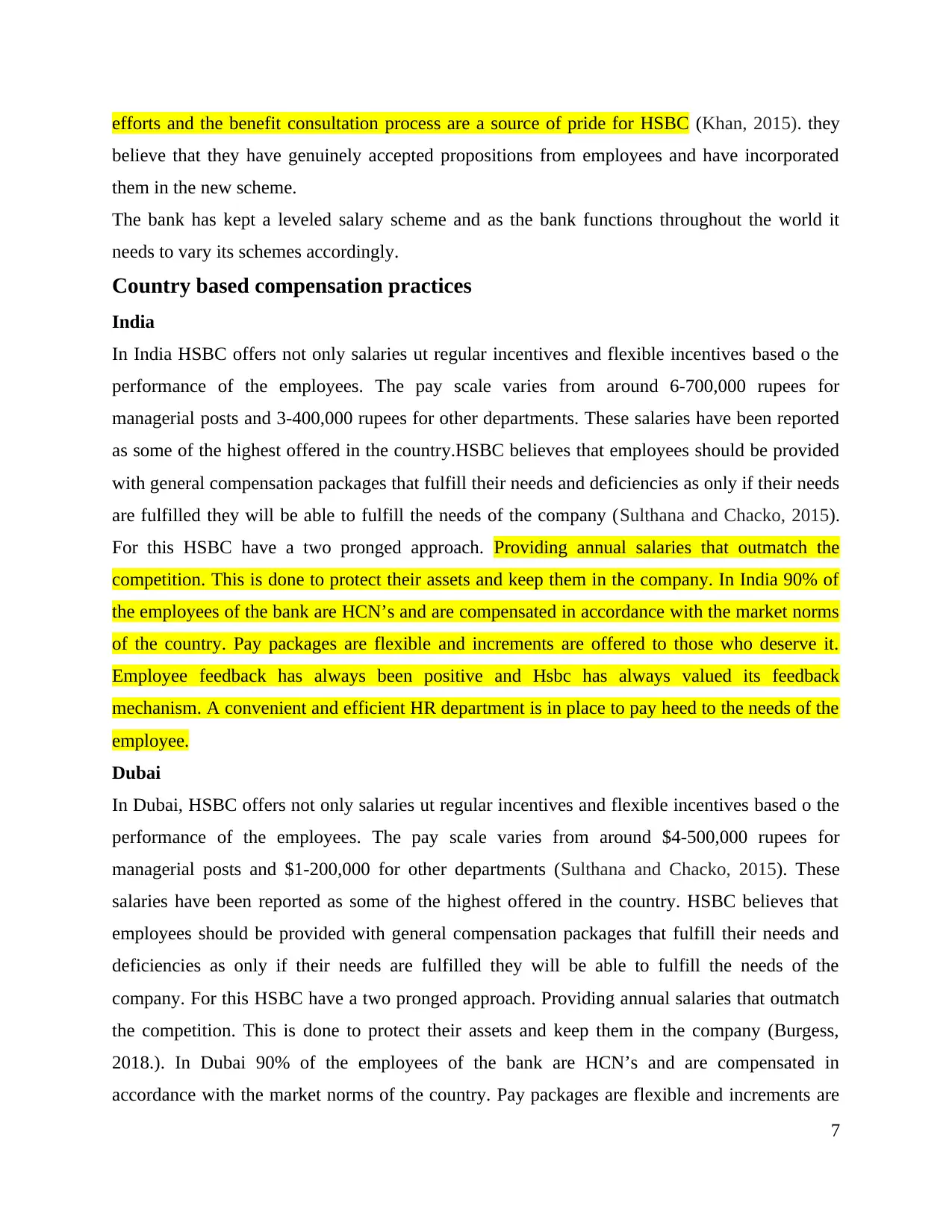
efforts and the benefit consultation process are a source of pride for HSBC (Khan, 2015). they
believe that they have genuinely accepted propositions from employees and have incorporated
them in the new scheme.
The bank has kept a leveled salary scheme and as the bank functions throughout the world it
needs to vary its schemes accordingly.
Country based compensation practices
India
In India HSBC offers not only salaries ut regular incentives and flexible incentives based o the
performance of the employees. The pay scale varies from around 6-700,000 rupees for
managerial posts and 3-400,000 rupees for other departments. These salaries have been reported
as some of the highest offered in the country.HSBC believes that employees should be provided
with general compensation packages that fulfill their needs and deficiencies as only if their needs
are fulfilled they will be able to fulfill the needs of the company (Sulthana and Chacko, 2015).
For this HSBC have a two pronged approach. Providing annual salaries that outmatch the
competition. This is done to protect their assets and keep them in the company. In India 90% of
the employees of the bank are HCN’s and are compensated in accordance with the market norms
of the country. Pay packages are flexible and increments are offered to those who deserve it.
Employee feedback has always been positive and Hsbc has always valued its feedback
mechanism. A convenient and efficient HR department is in place to pay heed to the needs of the
employee.
Dubai
In Dubai, HSBC offers not only salaries ut regular incentives and flexible incentives based o the
performance of the employees. The pay scale varies from around $4-500,000 rupees for
managerial posts and $1-200,000 for other departments (Sulthana and Chacko, 2015). These
salaries have been reported as some of the highest offered in the country. HSBC believes that
employees should be provided with general compensation packages that fulfill their needs and
deficiencies as only if their needs are fulfilled they will be able to fulfill the needs of the
company. For this HSBC have a two pronged approach. Providing annual salaries that outmatch
the competition. This is done to protect their assets and keep them in the company (Burgess,
2018.). In Dubai 90% of the employees of the bank are HCN’s and are compensated in
accordance with the market norms of the country. Pay packages are flexible and increments are
7
believe that they have genuinely accepted propositions from employees and have incorporated
them in the new scheme.
The bank has kept a leveled salary scheme and as the bank functions throughout the world it
needs to vary its schemes accordingly.
Country based compensation practices
India
In India HSBC offers not only salaries ut regular incentives and flexible incentives based o the
performance of the employees. The pay scale varies from around 6-700,000 rupees for
managerial posts and 3-400,000 rupees for other departments. These salaries have been reported
as some of the highest offered in the country.HSBC believes that employees should be provided
with general compensation packages that fulfill their needs and deficiencies as only if their needs
are fulfilled they will be able to fulfill the needs of the company (Sulthana and Chacko, 2015).
For this HSBC have a two pronged approach. Providing annual salaries that outmatch the
competition. This is done to protect their assets and keep them in the company. In India 90% of
the employees of the bank are HCN’s and are compensated in accordance with the market norms
of the country. Pay packages are flexible and increments are offered to those who deserve it.
Employee feedback has always been positive and Hsbc has always valued its feedback
mechanism. A convenient and efficient HR department is in place to pay heed to the needs of the
employee.
Dubai
In Dubai, HSBC offers not only salaries ut regular incentives and flexible incentives based o the
performance of the employees. The pay scale varies from around $4-500,000 rupees for
managerial posts and $1-200,000 for other departments (Sulthana and Chacko, 2015). These
salaries have been reported as some of the highest offered in the country. HSBC believes that
employees should be provided with general compensation packages that fulfill their needs and
deficiencies as only if their needs are fulfilled they will be able to fulfill the needs of the
company. For this HSBC have a two pronged approach. Providing annual salaries that outmatch
the competition. This is done to protect their assets and keep them in the company (Burgess,
2018.). In Dubai 90% of the employees of the bank are HCN’s and are compensated in
accordance with the market norms of the country. Pay packages are flexible and increments are
7
Paraphrase This Document
Need a fresh take? Get an instant paraphrase of this document with our AI Paraphraser
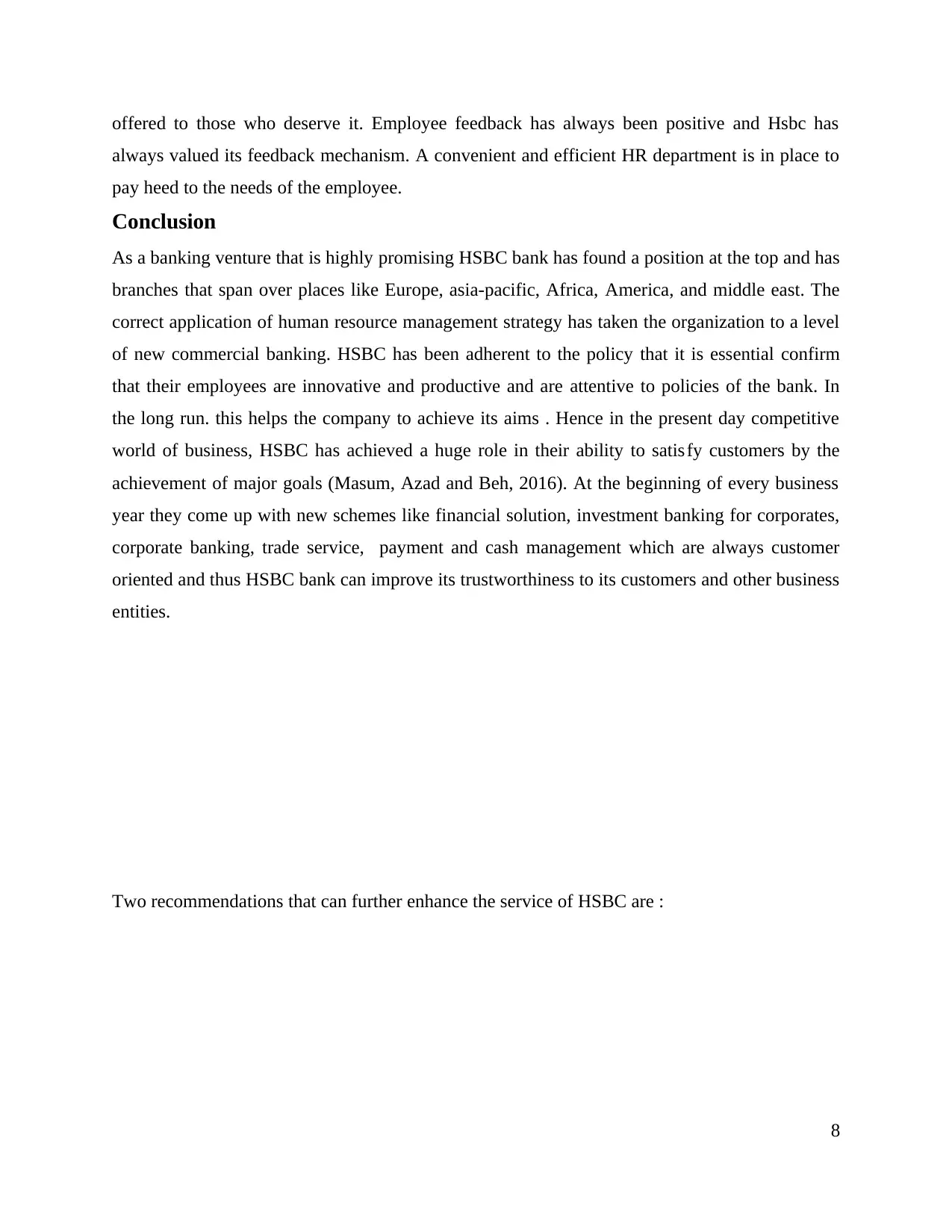
offered to those who deserve it. Employee feedback has always been positive and Hsbc has
always valued its feedback mechanism. A convenient and efficient HR department is in place to
pay heed to the needs of the employee.
Conclusion
As a banking venture that is highly promising HSBC bank has found a position at the top and has
branches that span over places like Europe, asia-pacific, Africa, America, and middle east. The
correct application of human resource management strategy has taken the organization to a level
of new commercial banking. HSBC has been adherent to the policy that it is essential confirm
that their employees are innovative and productive and are attentive to policies of the bank. In
the long run. this helps the company to achieve its aims . Hence in the present day competitive
world of business, HSBC has achieved a huge role in their ability to satisfy customers by the
achievement of major goals (Masum, Azad and Beh, 2016). At the beginning of every business
year they come up with new schemes like financial solution, investment banking for corporates,
corporate banking, trade service, payment and cash management which are always customer
oriented and thus HSBC bank can improve its trustworthiness to its customers and other business
entities.
Two recommendations that can further enhance the service of HSBC are :
8
always valued its feedback mechanism. A convenient and efficient HR department is in place to
pay heed to the needs of the employee.
Conclusion
As a banking venture that is highly promising HSBC bank has found a position at the top and has
branches that span over places like Europe, asia-pacific, Africa, America, and middle east. The
correct application of human resource management strategy has taken the organization to a level
of new commercial banking. HSBC has been adherent to the policy that it is essential confirm
that their employees are innovative and productive and are attentive to policies of the bank. In
the long run. this helps the company to achieve its aims . Hence in the present day competitive
world of business, HSBC has achieved a huge role in their ability to satisfy customers by the
achievement of major goals (Masum, Azad and Beh, 2016). At the beginning of every business
year they come up with new schemes like financial solution, investment banking for corporates,
corporate banking, trade service, payment and cash management which are always customer
oriented and thus HSBC bank can improve its trustworthiness to its customers and other business
entities.
Two recommendations that can further enhance the service of HSBC are :
8
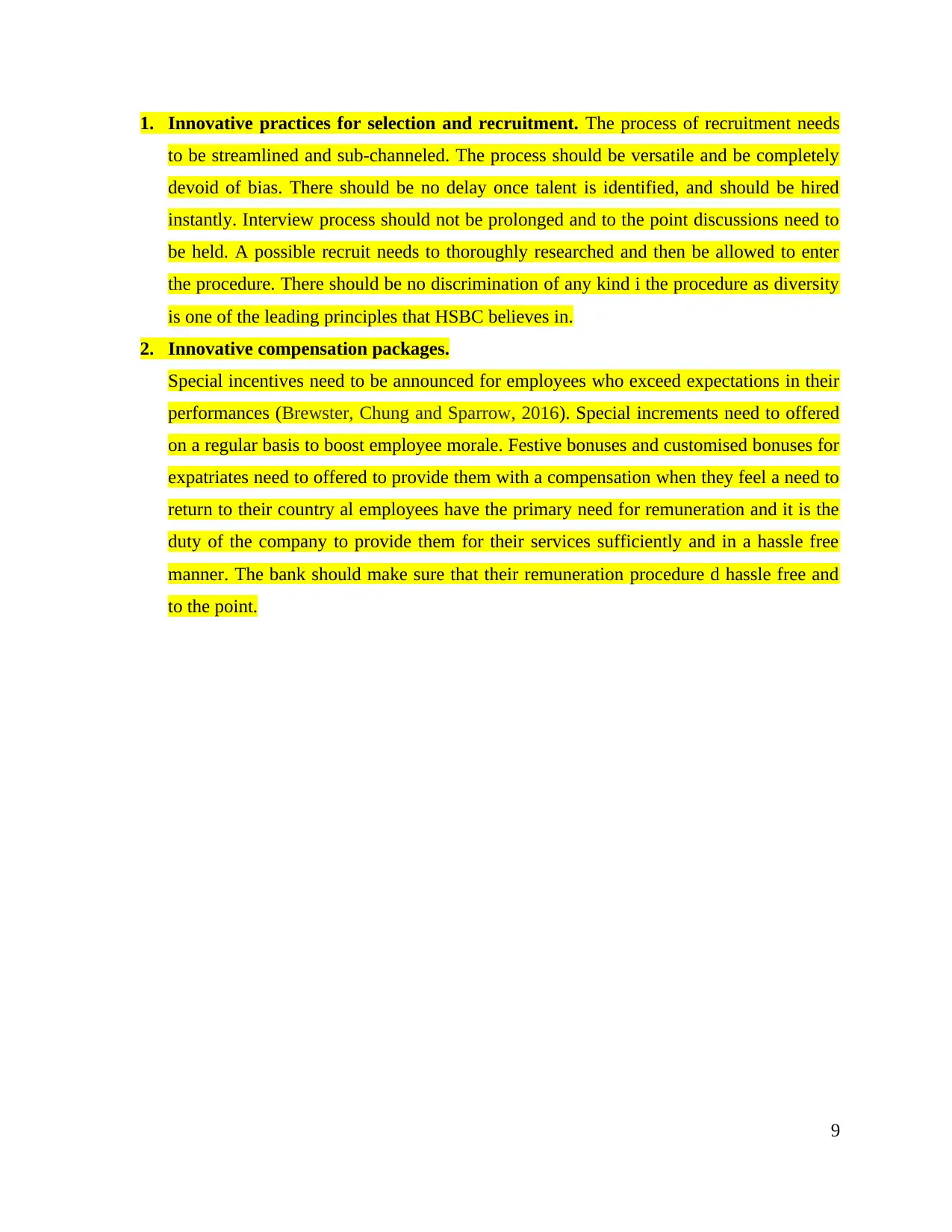
1. Innovative practices for selection and recruitment. The process of recruitment needs
to be streamlined and sub-channeled. The process should be versatile and be completely
devoid of bias. There should be no delay once talent is identified, and should be hired
instantly. Interview process should not be prolonged and to the point discussions need to
be held. A possible recruit needs to thoroughly researched and then be allowed to enter
the procedure. There should be no discrimination of any kind i the procedure as diversity
is one of the leading principles that HSBC believes in.
2. Innovative compensation packages.
Special incentives need to be announced for employees who exceed expectations in their
performances (Brewster, Chung and Sparrow, 2016). Special increments need to offered
on a regular basis to boost employee morale. Festive bonuses and customised bonuses for
expatriates need to offered to provide them with a compensation when they feel a need to
return to their country al employees have the primary need for remuneration and it is the
duty of the company to provide them for their services sufficiently and in a hassle free
manner. The bank should make sure that their remuneration procedure d hassle free and
to the point.
9
to be streamlined and sub-channeled. The process should be versatile and be completely
devoid of bias. There should be no delay once talent is identified, and should be hired
instantly. Interview process should not be prolonged and to the point discussions need to
be held. A possible recruit needs to thoroughly researched and then be allowed to enter
the procedure. There should be no discrimination of any kind i the procedure as diversity
is one of the leading principles that HSBC believes in.
2. Innovative compensation packages.
Special incentives need to be announced for employees who exceed expectations in their
performances (Brewster, Chung and Sparrow, 2016). Special increments need to offered
on a regular basis to boost employee morale. Festive bonuses and customised bonuses for
expatriates need to offered to provide them with a compensation when they feel a need to
return to their country al employees have the primary need for remuneration and it is the
duty of the company to provide them for their services sufficiently and in a hassle free
manner. The bank should make sure that their remuneration procedure d hassle free and
to the point.
9
⊘ This is a preview!⊘
Do you want full access?
Subscribe today to unlock all pages.

Trusted by 1+ million students worldwide
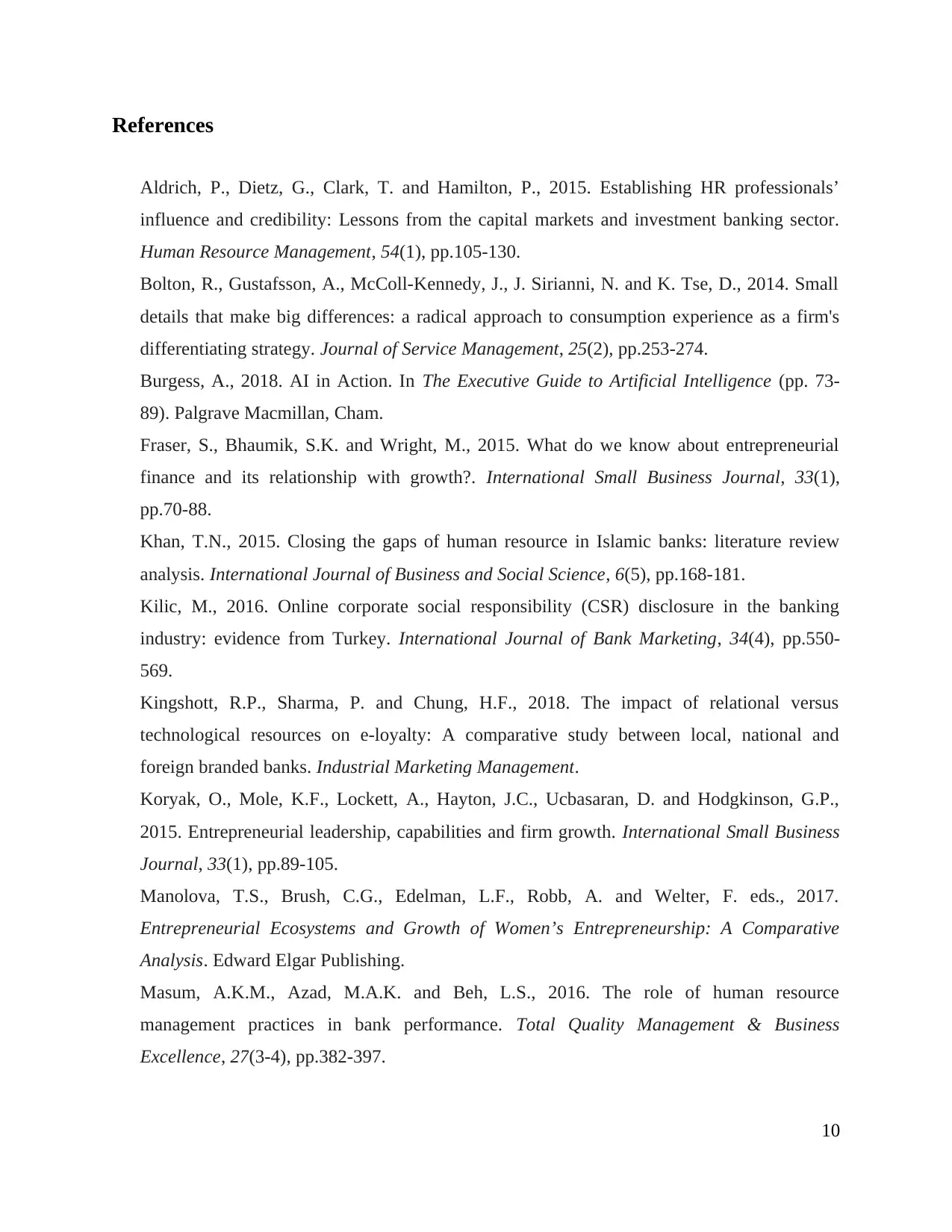
References
Aldrich, P., Dietz, G., Clark, T. and Hamilton, P., 2015. Establishing HR professionals’
influence and credibility: Lessons from the capital markets and investment banking sector.
Human Resource Management, 54(1), pp.105-130.
Bolton, R., Gustafsson, A., McColl-Kennedy, J., J. Sirianni, N. and K. Tse, D., 2014. Small
details that make big differences: a radical approach to consumption experience as a firm's
differentiating strategy. Journal of Service Management, 25(2), pp.253-274.
Burgess, A., 2018. AI in Action. In The Executive Guide to Artificial Intelligence (pp. 73-
89). Palgrave Macmillan, Cham.
Fraser, S., Bhaumik, S.K. and Wright, M., 2015. What do we know about entrepreneurial
finance and its relationship with growth?. International Small Business Journal, 33(1),
pp.70-88.
Khan, T.N., 2015. Closing the gaps of human resource in Islamic banks: literature review
analysis. International Journal of Business and Social Science, 6(5), pp.168-181.
Kilic, M., 2016. Online corporate social responsibility (CSR) disclosure in the banking
industry: evidence from Turkey. International Journal of Bank Marketing, 34(4), pp.550-
569.
Kingshott, R.P., Sharma, P. and Chung, H.F., 2018. The impact of relational versus
technological resources on e-loyalty: A comparative study between local, national and
foreign branded banks. Industrial Marketing Management.
Koryak, O., Mole, K.F., Lockett, A., Hayton, J.C., Ucbasaran, D. and Hodgkinson, G.P.,
2015. Entrepreneurial leadership, capabilities and firm growth. International Small Business
Journal, 33(1), pp.89-105.
Manolova, T.S., Brush, C.G., Edelman, L.F., Robb, A. and Welter, F. eds., 2017.
Entrepreneurial Ecosystems and Growth of Women’s Entrepreneurship: A Comparative
Analysis. Edward Elgar Publishing.
Masum, A.K.M., Azad, M.A.K. and Beh, L.S., 2016. The role of human resource
management practices in bank performance. Total Quality Management & Business
Excellence, 27(3-4), pp.382-397.
10
Aldrich, P., Dietz, G., Clark, T. and Hamilton, P., 2015. Establishing HR professionals’
influence and credibility: Lessons from the capital markets and investment banking sector.
Human Resource Management, 54(1), pp.105-130.
Bolton, R., Gustafsson, A., McColl-Kennedy, J., J. Sirianni, N. and K. Tse, D., 2014. Small
details that make big differences: a radical approach to consumption experience as a firm's
differentiating strategy. Journal of Service Management, 25(2), pp.253-274.
Burgess, A., 2018. AI in Action. In The Executive Guide to Artificial Intelligence (pp. 73-
89). Palgrave Macmillan, Cham.
Fraser, S., Bhaumik, S.K. and Wright, M., 2015. What do we know about entrepreneurial
finance and its relationship with growth?. International Small Business Journal, 33(1),
pp.70-88.
Khan, T.N., 2015. Closing the gaps of human resource in Islamic banks: literature review
analysis. International Journal of Business and Social Science, 6(5), pp.168-181.
Kilic, M., 2016. Online corporate social responsibility (CSR) disclosure in the banking
industry: evidence from Turkey. International Journal of Bank Marketing, 34(4), pp.550-
569.
Kingshott, R.P., Sharma, P. and Chung, H.F., 2018. The impact of relational versus
technological resources on e-loyalty: A comparative study between local, national and
foreign branded banks. Industrial Marketing Management.
Koryak, O., Mole, K.F., Lockett, A., Hayton, J.C., Ucbasaran, D. and Hodgkinson, G.P.,
2015. Entrepreneurial leadership, capabilities and firm growth. International Small Business
Journal, 33(1), pp.89-105.
Manolova, T.S., Brush, C.G., Edelman, L.F., Robb, A. and Welter, F. eds., 2017.
Entrepreneurial Ecosystems and Growth of Women’s Entrepreneurship: A Comparative
Analysis. Edward Elgar Publishing.
Masum, A.K.M., Azad, M.A.K. and Beh, L.S., 2016. The role of human resource
management practices in bank performance. Total Quality Management & Business
Excellence, 27(3-4), pp.382-397.
10
Paraphrase This Document
Need a fresh take? Get an instant paraphrase of this document with our AI Paraphraser
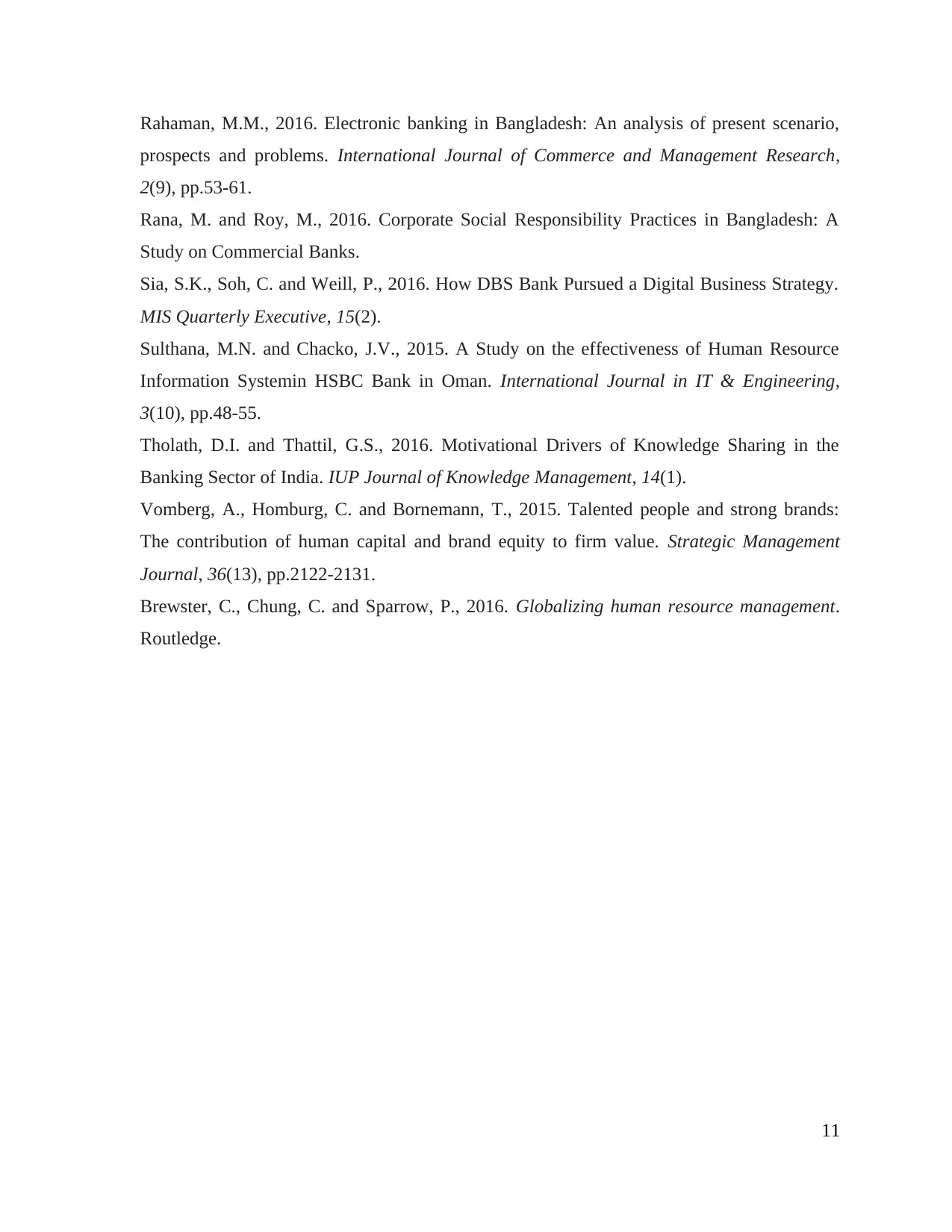
Rahaman, M.M., 2016. Electronic banking in Bangladesh: An analysis of present scenario,
prospects and problems. International Journal of Commerce and Management Research,
2(9), pp.53-61.
Rana, M. and Roy, M., 2016. Corporate Social Responsibility Practices in Bangladesh: A
Study on Commercial Banks.
Sia, S.K., Soh, C. and Weill, P., 2016. How DBS Bank Pursued a Digital Business Strategy.
MIS Quarterly Executive, 15(2).
Sulthana, M.N. and Chacko, J.V., 2015. A Study on the effectiveness of Human Resource
Information Systemin HSBC Bank in Oman. International Journal in IT & Engineering,
3(10), pp.48-55.
Tholath, D.I. and Thattil, G.S., 2016. Motivational Drivers of Knowledge Sharing in the
Banking Sector of India. IUP Journal of Knowledge Management, 14(1).
Vomberg, A., Homburg, C. and Bornemann, T., 2015. Talented people and strong brands:
The contribution of human capital and brand equity to firm value. Strategic Management
Journal, 36(13), pp.2122-2131.
Brewster, C., Chung, C. and Sparrow, P., 2016. Globalizing human resource management.
Routledge.
11
prospects and problems. International Journal of Commerce and Management Research,
2(9), pp.53-61.
Rana, M. and Roy, M., 2016. Corporate Social Responsibility Practices in Bangladesh: A
Study on Commercial Banks.
Sia, S.K., Soh, C. and Weill, P., 2016. How DBS Bank Pursued a Digital Business Strategy.
MIS Quarterly Executive, 15(2).
Sulthana, M.N. and Chacko, J.V., 2015. A Study on the effectiveness of Human Resource
Information Systemin HSBC Bank in Oman. International Journal in IT & Engineering,
3(10), pp.48-55.
Tholath, D.I. and Thattil, G.S., 2016. Motivational Drivers of Knowledge Sharing in the
Banking Sector of India. IUP Journal of Knowledge Management, 14(1).
Vomberg, A., Homburg, C. and Bornemann, T., 2015. Talented people and strong brands:
The contribution of human capital and brand equity to firm value. Strategic Management
Journal, 36(13), pp.2122-2131.
Brewster, C., Chung, C. and Sparrow, P., 2016. Globalizing human resource management.
Routledge.
11
1 out of 11
Related Documents
Your All-in-One AI-Powered Toolkit for Academic Success.
+13062052269
info@desklib.com
Available 24*7 on WhatsApp / Email
![[object Object]](/_next/static/media/star-bottom.7253800d.svg)
Unlock your academic potential
Copyright © 2020–2025 A2Z Services. All Rights Reserved. Developed and managed by ZUCOL.





